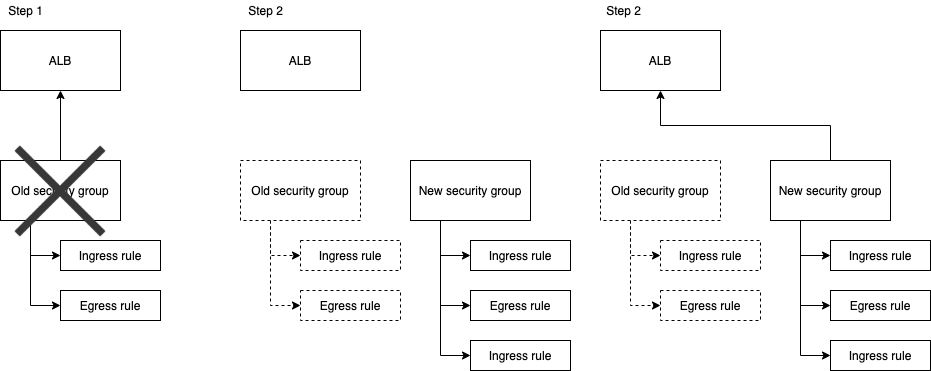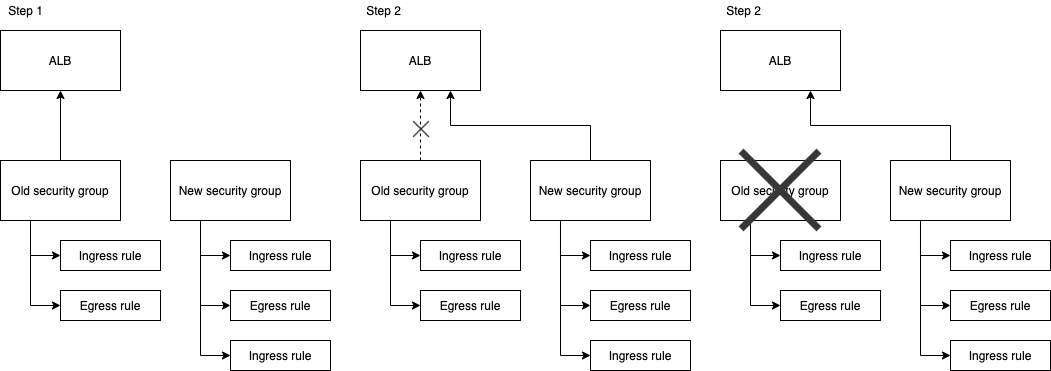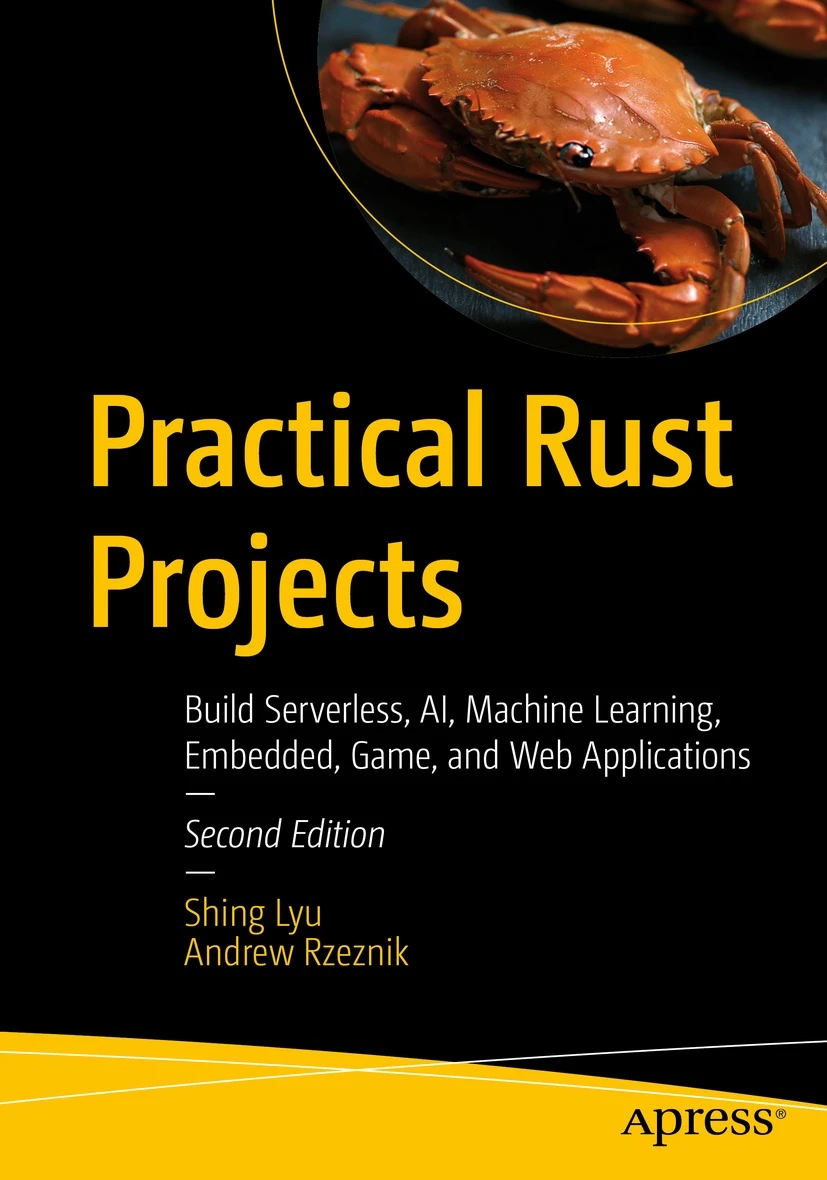Update AWS Security Groups with Terraform
Disclaimer: This content reflects my personal opinions, not those of any organizations I am or have been affiliated with. Code samples are provided for illustration purposes only, use with caution and test thoroughly before deployment.
In theory, Terraform is capable of figuring out the dependency between AWS resources and make updates in the correct order. However, AWS security groups often become a source of trouble if you don’t understand how Terraform handles it. If you are having issues modifying the security group because they are used by other resources, here are some ways you can mitigate that.
If we have the following security group:
resource "aws_security_group" "allow_http_traffic" {
name = "allow_http_traffic"
vpc_id = aws_vpc.example.id // not relavent
ingress {
from_port = "80"
to_port = "80"
protocol = "tcp"
cidr_blocks = ["10.0.1.0/24"]
}
egress {
from_port = 0
to_port = 0
protocol = "-1"
cidr_blocks = ["0.0.0.0/0"]
}
}
This security group has two rules; it allows inbound traffic from the 10.0.1.0/24 IP range on port 80, and allows all outbound traffic. This security group is used by an application load balancer to control the traffic:
resource "aws_lb" "example" {
name = "example_load_balancer"
load_balancer_type = "application"
security_groups = [aws_security_group.allow_http_traffic.id] // Security group referenced here
internal = true
subnets = [aws_subnet.example.*.*.id] // Not relavent
}
The architecture looks like this:

Now if we try to allow another IP range to access this ALB, we add a new ingress rule to the security group:
resource "aws_security_group" "allow_http_traffic" {
name = "allow_http_traffic"
vpc_id = aws_vpc.example.id // not relavent
ingress {
// omitted
cidr_blocks = ["10.0.1.0/24"]
}
egress {
// omitted
cidr_blocks = ["0.0.0.0/0"]
}
ingress { // New ingress rule
from_port = "80"
to_port = "80"
protocol = "tcp"
cidr_blocks = ["10.0.2.0/24"]
}
}
You might see the terraform apply runs for a very long time and finally fails with an error:
aws_security_group.allow_http_traffic: Still destroying... [id=sg-02e90ca52c7b4484a, 0m10s elapsed]
// ... the same message goes on for 10 minutes
aws_security_group.allow_http_traffic: Still destroying... [id=sg-02e90ca52c7b4484a, 9m40s elapsed]
aws_security_group.allow_http_traffic: Still destroying... [id=sg-02e90ca52c7b4484a, 9m50s elapsed]
aws_security_group.allow_http_traffic: Still destroying... [id=sg-02e90ca52c7b4484a, 10m0s elapsed]
Error: DependencyViolation: resource sg-02e90ca52c7b4484a has a dependent object
status code: 400, request id: a1814f80-9eea-414c-bbc2-6685b0bf1129
Destroy-before-create v.s. Create-before-destroy
This is actually caused by they way Terraform tries to update the security group. If we look into the terraform plan output:
# aws_security_group.allow_http_traffic must be replaced
-/+ resource "aws_security_group" "allow_http_traffic" {
// ... omitted
}
By default, if Terraform thinks the resource can’t be updated in-place, it will try first to destroy the resource and create a new one. The -/+ symbol in the terraform plan output confirms that. This is illustrated in the following diagram:

However, AWS doesn’t allow you to destroy a security group while the application load balancer is using it. So Terraform will be stuck in step 1, trying to destroy the security group until it times out.
The solution is to:
- create a new security group
- Re-configure the application load balancer, so it uses the new security group instead of the old one.
- Now the old security group is not referenced by anyone anymore. We can safely delete it.

Terraform has a lifecycle block that allows you to overwrite how Terraform handles the resource’s lifecycle. More specifically, the create_before_destory argument is what we are looking for. The documentation says:
The
create_before_destroymeta-argument changes this behavior so that the new replacement object is created first, and then the prior object is destroyed only once the replacement is created.
So if we change our security group resource according to the following snippet, we can get the desired behavior:
resource "aws_security_group" "allow_http_traffic" {
name = "allow_http_traffic"
vpc_id = aws_vpc.example.id // not relavent
ingress {
// omitted
cidr_blocks = ["10.0.1.0/24"]
}
egress {
// omitted
cidr_blocks = ["0.0.0.0/0"]
}
ingress { // New ingress rule
from_port = "80"
to_port = "80"
protocol = "tcp"
cidr_blocks = ["10.0.2.0/24"]
}
lifecycle {
create_before_destroy = true
}
}
Name conflict
If we run terraform apply now, we’ll get another issue:
aws_security_group.allow_http_traffic: Creating...
Error: Error creating Security Group: InvalidGroup.Duplicate: The security group 'allow_http_traffic' already exists for VPC 'vpc-03a1b980a68f57ab3'
status code: 400, request id: 0ad62c71-99cc-448a-91c0-38fe19a1adaa
on alb.tf line 1, in resource "aws_security_group" "allow_http_traffic":
1: resource "aws_security_group" "allow_http_traffic" {
The error message is pretty self-explanatory: when Terraform tries to create the new security group, it has the same name as the existing one. You’ll have to change the name of the security group so Terraform can create a new security group with a new name.
If you run out of ideas for naming, you can consider adding a sequence number to the end of the name, like allow_http_traffic_1, allow_http_traffic_2, and so on. Or you can automate that with a variable like the commit hash (allow_http_traffic_${var.commit_hash}), and let the CI pipeline present the commit hash as a Terraform variable. The drawback of the commit-hash approach is that it will force the security group to be re-created on every commit. If your Terraform code lives alongside the application code in the same repository, that might be a waste of deployment time. Usually, the security group won’t change too often, so it’ll be easier just to rename them manually.
